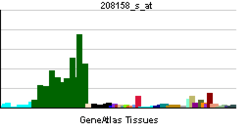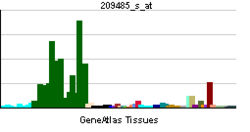OSBPL1A
Oxysterol-binding protein-related protein 1 is a protein that in humans is encoded by the OSBPL1A gene.[3][4][5]
This gene encodes a member of the oxysterol-binding protein (OSBP) family, a group of intracellular lipid receptors. Most members contain an N-terminal pleckstrin homology domain and a highly conserved C-terminal OSBP-like sterol-binding domain, although some members contain only the sterol-binding domain. Transcript variants derived from alternative promoter usage and/or alternative splicing exist; they encode different isoforms.[5]
References
Further reading
- Lehto M, Laitinen S, Chinetti G, et al. (2001). "The OSBP-related protein family in humans.". J. Lipid Res. 42 (8): 1203–13. PMID 11483621.
- Jaworski CJ, Moreira E, Li A, et al. (2002). "A family of 12 human genes containing oxysterol-binding domains.". Genomics. 78 (3): 185–96. doi:10.1006/geno.2001.6663. PMID 11735225.
- Strausberg RL, Feingold EA, Grouse LH, et al. (2003). "Generation and initial analysis of more than 15,000 full-length human and mouse cDNA sequences.". Proc. Natl. Acad. Sci. U.S.A. 99 (26): 16899–903. doi:10.1073/pnas.242603899. PMC 139241
 . PMID 12477932.
. PMID 12477932.
- Johansson M, Bocher V, Lehto M, et al. (2004). "The two variants of oxysterol binding protein-related protein-1 display different tissue expression patterns, have different intracellular localization, and are functionally distinct.". Mol. Biol. Cell. 14 (3): 903–15. doi:10.1091/mbc.E02-08-0459. PMC 151568
 . PMID 12631712.
. PMID 12631712.
- Ota T, Suzuki Y, Nishikawa T, et al. (2004). "Complete sequencing and characterization of 21,243 full-length human cDNAs.". Nat. Genet. 36 (1): 40–5. doi:10.1038/ng1285. PMID 14702039.
- Johansson M, Lehto M, Tanhuanpää K, et al. (2006). "The oxysterol-binding protein homologue ORP1L interacts with Rab7 and alters functional properties of late endocytic compartments.". Mol. Biol. Cell. 16 (12): 5480–92. doi:10.1091/mbc.E05-03-0189. PMC 1289395
 . PMID 16176980.
. PMID 16176980.
- Olsen JV, Blagoev B, Gnad F, et al. (2006). "Global, in vivo, and site-specific phosphorylation dynamics in signaling networks.". Cell. 127 (3): 635–48. doi:10.1016/j.cell.2006.09.026. PMID 17081983.


 . PMID 12477932.
. PMID 12477932. . PMID 12631712.
. PMID 12631712. . PMID 16176980.
. PMID 16176980.